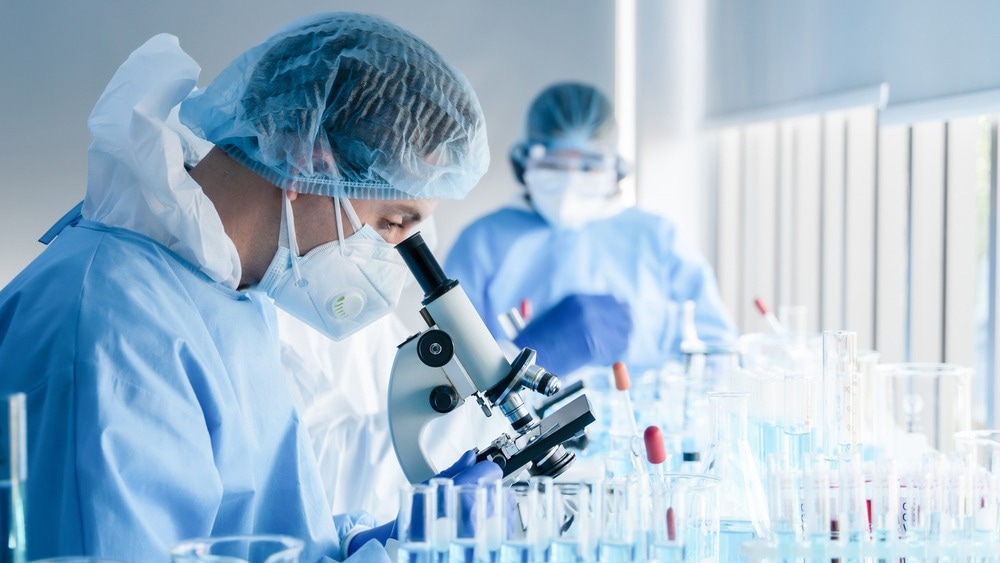Scientists from Wuyi University’s School of Textile Materials and Engineering have published a new paper exploring the use of 3D-printed biomaterials for preparing multifunctional scaffold materials for biomedical applications. Their research has appeared in the journal Composites Communications.

Study: Assembling a multi-component and multifunctional integrated filament scaffold based on triaxial 3D bioprinting technology Image Credit: Mongkolchon Akesin/Shutterstock.com
3D Bioprinting and Biomaterials: Meeting Key Biomedical Challenges
The field of biomedical science demands advanced materials which can meet the demands of multiple applications such as drug delivery, implantable devices, and tissue engineering. Recently, the field of 3D bioprinting has emerged as a forerunner in providing solutions to several key issues within the biomedical field.
3D bioprinting exploits additive manufacturing methods such as direct ink jet writing, extrusion-based techniques, and light-assisted 3D printing to produce functional 3D structured materials for biomedical uses. With these techniques, products can be produced layer-by-layer with high resolution, cost-effectiveness, scalability, and accurate control of three-dimensional scaffold architectures.
Recent research has explored multiple bio-based materials for use in 3D bioprinting as functional hydrogel scaffolds. Chitosan, gelatine, collagen, and sodium alginate are natural polymers that have displayed enormous potential in several biomedical fields. These materials possess beneficial properties which make them highly attractive for medical research.
For instance, chitosan possesses good hemostatic and antibacterial properties. Gelatine and collagen, which are found in the extracellular matrix of animal tissues, regulate cell behaviors such as differentiation, proliferation, migration, and good biocompatibility. Sodium alginate possesses superior water absorption and retention and has excellent biodegradability.
Platelet-rich blood plasma is also used in this field due to its ability to secrete multiple growth factors, including vascular endothelial growth factor and platelet-derived growth factor. Growth factors can promote beneficial cell behaviors such as growth, proliferation, and regeneration by interacting with the patient’s native environment.
3D bioprinting can integrate all these components, which gives it immense potential for 3D hydrogel scaffold fabrication. Triaxial bioprinting is an advanced 3D printing technology that has been explored in recent years for the production of multifunctional scaffolds.
The Paper
In the new paper in Composites Communications, the authors have demonstrated the development of a multifunctional and multi-component 3D hydrogel scaffold using triaxial 3D bioprinting techniques.
The raw materials selected for the scaffolds are chitosan, sodium alginate, collagen, gelatine, and platelet-rich plasma. Platelet-rich plasma was encapsulated in the scaffold’s core layer using triaxial 3D bioprinting. Then, a bioactive filament scaffold was designed which acts as the basic unit for integration with other biomaterials. The filament scaffold possesses a three-layered shell-core structure.
Preparation of the hydrogel scaffolds was achieved using a one-step sequential deposition process. Gelatine was passed at the inner phase, sodium alginate at the middle phase, and chitosan/collagen at the outer phase. Electrostatic complexation of the chitosan/collagen outer shell layer and the sodium alginate middle layer led to the construction of stable shell-core filaments.
Steric hindrance effects provided by the filamentous scaffold construction protect the platelet’s function and morphology via the effect of encapsulation. Controlled mixing ratios of collagen and chitosan gave the filaments excellent cell recruitment and antibacterial abilities. The total diameter of the filaments was 700-800 μm.
Mechanical Performance, Antibacterial, Biocompatibility, and Chronic Wound Repair Performance
Mechanical performance tests revealed that the scaffolds have high swelling ratios and degraded severely within 120 hours. Furthermore, the scaffolds have superior water absorption and retention capacities. After centrifugation, both scaffolds retained up to sixteen times their own weight in water.
To evaluate the antimicrobial properties of the scaffolds, which are essential for commercial biomedical applications, the prepared filaments were cultured with gram-positive S. aureus and gram-negative E. coli. Live/dead bacterial tests with both bacterial strains revealed effective inhibition by the scaffolds due to the presence of chitosan in the filamentous shell.
L929 cells were used to assess the biocompatibility of scaffolds as a research model. Proliferation experiments were performed using Cell Counting Kit-8. After seven days, one of the scaffolds (CTCoNG) displayed 78.4% cell adhesion rates. A scratch cell assay was performed to assess cell migration abilities. This test revealed a better migration activity than the control group. Differences in cell migration were attributed to collagen content differences.
Fluorescent staining and imaging revealed the morphology changes in L929 fibroblasts which were induced by the scaffolds, demonstrating their high biocompatibility.
Animal models were used to evaluate the chronic wound repair performance of the novel 3D scaffolds, with experiments demonstrating superior performance to clinical PRP gel. The authors highlighted the role of triaxial 3D bioprinting in enhancing this performance due to its ability to integrate multi-component materials with good functionalities such as antibacterial activity, biocompatibility, and water absorption and retention.
In Summary
The paper has demonstrated a novel and innovative approach to constructing multifunctional 3D hydrogel filamentous scaffolds out of multiple component biomaterials. These scaffolds display excellent properties and performance in wound healing, which could significantly improve health outcomes for patients.
More from AZoM: A Closer Look at Semiconductor Test Equipment
Reference
Wu, T., et al. (2022) Assembling a multi-component and multifunctional integrated filament scaffold based on triaxial 3D bioprinting technology Composite Communications 101303 [Online, pre-proof] sciencedirect.com. Available at: https://doi.org/10.1016/j.coco.2022.101303
Disclaimer: The views expressed here are those of the author expressed in their private capacity and do not necessarily represent the views of AZoM.com Limited T/A AZoNetwork the owner and operator of this website. This disclaimer forms part of the Terms and conditions of use of this website.